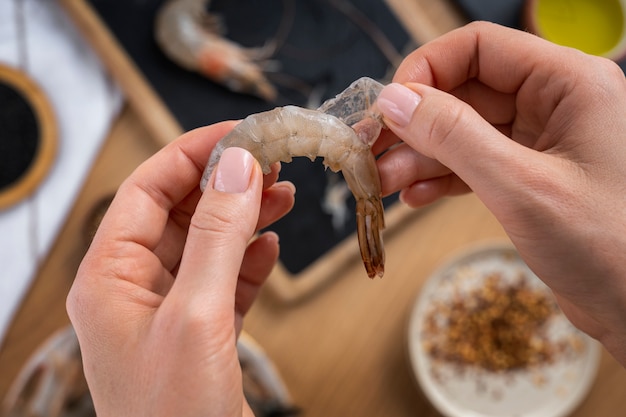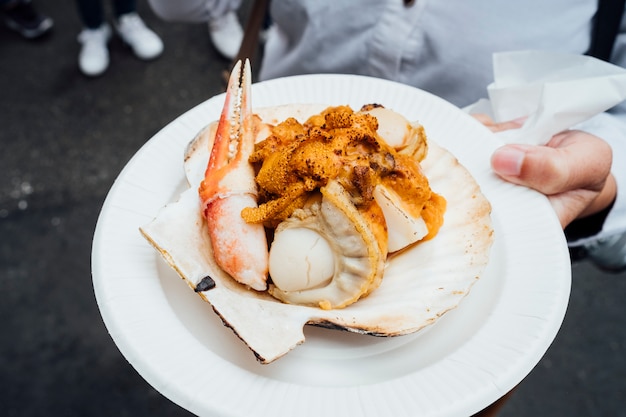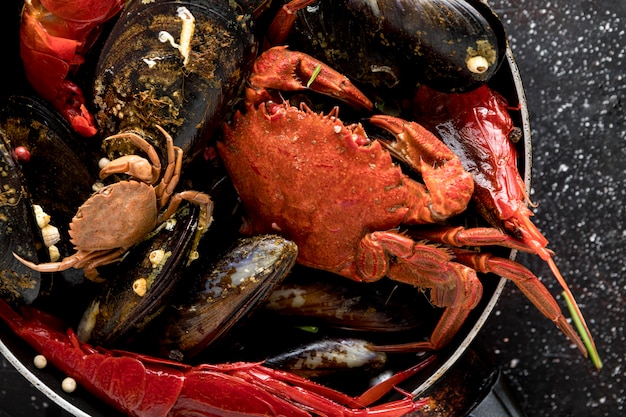You've got your hands on some beautiful, fresh blue crabs! Whether you snagged them yourself or got them from a local fishmonger, you're probably eager to get them into the pot and onto your plate. But hold on a sec, mate! Cooking blue crabs just right is a bit of an art form. It's all about hitting that sweet spot where the meat is tender and juicy, and the shell is easy to crack. Nobody wants a tough, chewy crab, right? And who wants to wrestle with a shell that's practically unbreakable?
Don't worry, though. I'm here to guide you through it. I've been cooking blue crabs for years, and I've learned a thing or two along the way. I'm going to share my secrets, my tips, my tricks – everything I know about getting that perfect blue crab cook. So, grab a cuppa, sit back, and let's get started!
(Part 1) The Size Matters

The first thing you need to consider is the size of your crabs. A small crab will cook faster than a big one, which is pretty obvious, really. But it's not just about the overall size. The thickness of the crab's shell also plays a crucial role. A thicker shell will take longer to cook through than a thinner one.
Knowing Your Crab: Size and Shell Thickness
Now, I know you might be thinking, "How am I supposed to know how thick the shell is?" Well, there are a few ways to judge. First, look at the crab's body. A bigger, wider body usually means a thicker shell. Second, you can feel the shell. A thicker shell will feel more substantial, almost like a tiny shield.
Cooking Time Considerations
So, why does this matter for cooking time? If you cook a small, thin-shelled crab for the same time as a large, thick-shelled crab, the small one could end up overcooked and dry, while the large one might still be undercooked. And that's a recipe for disaster, trust me!
Here's a table I've put together to give you an idea of the cooking times for different crab sizes:
| Crab Size | Cooking Time |
|---|---|
| Small (under 4 inches across) | 10-15 minutes |
| Medium (4-6 inches across) | 15-20 minutes |
| Large (over 6 inches across) | 20-25 minutes |
Remember, these are just estimates. It's always best to check for doneness, which I'll get into in a bit.
(Part 2) The Water's the Key

Right, now we're getting into the nitty-gritty. The water you cook your crabs in is just as important as the crabs themselves. You want to make sure it's seasoned just right, and you want to keep it boiling throughout the entire cooking process.
Seasoning Your Water: The Classic Method and Beyond
The classic way to season crab water is with salt and vinegar. A good rule of thumb is to use 1 tablespoon of salt and 1/2 cup of vinegar for every gallon of water. I prefer to use white vinegar, but apple cider vinegar works well too.
But you don't have to stick to just salt and vinegar. Get creative with your seasonings! Some folks like to add things like bay leaves, black peppercorns, or even a bit of old bay seasoning. Experiment and see what you like best!
Maintaining a Boiling Point
Once your water is boiling, carefully add your crabs to the pot. Make sure you don't overcrowd the pot, or the water won't stay boiling. And don't just chuck them in! You want to add them slowly, so you don't splash boiling water everywhere.
Now, keep the heat high to maintain that rolling boil! You need a good, consistent boil to cook the crabs properly. If the water stops boiling, the crabs won't cook evenly and might even end up rubbery. Be careful, though, as steam from the boiling water can be quite hot and intense.
(Part 3) The doneness test: How to Know When Your Crabs are Ready

Alright, so you've got your crabs boiling away. Now, how do you know when they're done? This is where a bit of intuition and experience come in. But don't worry, I'll give you the tools you need to judge.
The Color Test: A Visual Indicator
One way to tell is by looking at the crab's color. When it's cooked, the crab's shell will turn a vibrant, bright red. You'll know it's ready when it's that beautiful, reddish-orange hue.
The Shell Test: Checking for Firmness
Another test is to check the crab's shell. A cooked crab's shell will be firm and easy to crack. If you can easily break the shell with your fingers, it's ready to eat.
The Meat Test: The Ultimate Confirmation
But the ultimate test is to check the meat itself. Use a fork to pry open a leg or a claw. If the meat is white and opaque, it's cooked through. If it's still translucent, give it a few more minutes.
(Part 4) Time to Feast! Enjoying Your Perfectly Cooked Crabs
Congratulations, mate! You've successfully cooked your blue crabs. Now it's time to enjoy your hard work. But before you dive in, let me share a few tips for eating your crabs.
Choosing Your Tools: Cracking Those Shells Open
You'll need a few tools for cracking those shells open and getting at that delicious meat. You can use a crab cracker, a hammer, or even a pair of pliers. But I find that a good old-fashioned butter knife does the trick just fine.
Cleaning Up: Embrace the Mess
And remember, blue crabs are messy eaters. Be sure to have plenty of napkins or paper towels on hand. And maybe even wear an old shirt you don't mind getting stained. But hey, that's all part of the fun, right?
The Joy of Cracking: A Hands-On Experience
Cracking open a blue crab and getting at that sweet, juicy meat is a real treat. It's a hands-on experience, a bit of a messy adventure. But the reward is worth it, I promise you. The taste, the texture, the feeling of satisfaction – it's all part of the blue crab experience.
(Part 5) Let's Talk About Storage: Keeping Those Crabs Fresh
Okay, so you've cooked up a batch of delicious blue crabs, but what if you have leftovers? Or what if you want to cook a big batch and eat them over a few days? Don't worry, I've got you covered. There are a few ways to store your cooked blue crabs, and I'll guide you through the best methods.
Refrigeration: For Short-Term Storage
If you're planning on eating your crabs within a day or two, the fridge is your best bet. First, let the crabs cool down to room temperature. Then, store them in an airtight container in the refrigerator. Just be sure to use a container that's big enough to allow for proper airflow. This way, the crabs will stay fresh and flavorful.
Freezing: For Longer-Term Storage
Now, if you want to store your crabs for a longer period, freezing is the way to go. Again, let the crabs cool down first. Then, you can freeze them whole or pick out the meat and freeze it separately.
For freezing whole crabs, wrap them individually in plastic wrap and then place them in a freezer-safe bag. Label the bag with the date so you know when they were frozen.
If you're freezing the meat, you can store it in airtight containers or freezer-safe bags. Remember to label them as well.
Thawing: Bringing Those Frozen Crabs Back to Life
When you're ready to eat your frozen crabs, you can thaw them in the refrigerator overnight. Just place the container or bag in the fridge and allow them to thaw slowly. You can also thaw them in a bowl of cold water, but make sure the water is constantly changing.
Once they're thawed, you can reheat the crabs in a steamer or in the oven. Or you can eat them cold, straight out of the fridge. It's up to you!
(Part 6) Beyond the Basics: Mastering the Art of Blue Crab Cooking
Now, I've shared the basics with you. You know how to choose your crabs, cook them, and store them. But there's always more to learn, right? Cooking blue crabs is a bit of an art form, and there are always new things to discover.
The Steaming Method: A Healthier, Flavor-Preserving Option
For example, have you ever tried steaming your blue crabs? It's a method that's gaining popularity, and it has a few advantages. First, it's a healthier way to cook because it doesn't use any oil. Second, it helps preserve the crab's natural flavors. And third, it's a really easy way to cook.
To steam your crabs, you'll need a steamer basket and a pot with a tight-fitting lid. Place the crabs in the steamer basket and add about an inch of water to the pot. Bring the water to a boil and then lower the heat to a simmer. Steam the crabs for about 15-20 minutes, or until they're cooked through.
Adding Herbs and Spices: A Flavorful Twist
You can also get creative with your seasonings. Try adding fresh herbs like thyme, rosemary, or parsley to your boiling water. Or experiment with different spices like Old Bay seasoning, paprika, or cayenne pepper. Let your creativity flow!
Experimenting with Flavors: Exploring New Culinary Horizons
And remember, you don't have to stick to just steaming or boiling. You can try grilling your crabs, baking them, or even frying them. The possibilities are endless! Don't be afraid to try new things and see what works best for you. Blue crabs are very versatile and can be cooked in many different ways.
(Part 7) The Joy of Blue Crabs: A Culinary and Cultural Experience
You know, there's something special about blue crabs. They're not just a meal, they're an experience. It's the joy of cracking open a shell, the anticipation of tasting that sweet, delicate meat. It's the shared experience of feasting with friends and family. It's the taste of summer, the taste of the sea.
I love blue crabs because they remind me of my childhood. Growing up, my family would go crabbing every summer, and it was always an adventure. We'd spend hours on the pier, throwing out our lines and waiting for that telltale tug. Then we'd bring our catch home and cook them up in a big pot. It was a tradition, a family ritual.
And even today, whenever I cook blue crabs, I can't help but feel a sense of nostalgia. It takes me back to those carefree summer days, filled with laughter, sunshine, and the promise of a delicious meal. It's a memory that's tied to food, family, and fun.
(Part 8) FAQs: Your Blue Crab Queries Answered
I've tried to cover everything, but I know you might still have some questions. So, here are a few frequently asked questions about blue crab cooking.
1. How do I know if a crab is alive?
A live crab will have its claws moving, and its body will be firm and hard. If the crab is limp and unresponsive, it's probably dead. If you're buying crabs, it's always best to look for ones that are lively and active, as this is a sign of freshness.
2. What's the best way to clean a crab?
The best way to clean a blue crab is to remove the apron (the triangular flap on the underside), the gills (the feathery things inside the body), and the mouth (the small, pointed part at the front of the head). You can use a sharp knife or a pair of kitchen shears to do this.
Cleaning crabs can seem a bit intimidating at first, but it's actually quite simple once you get the hang of it. There are plenty of helpful videos and resources online that can guide you through the process.
3. Can I cook crabs frozen?
It's not recommended to cook crabs frozen. The meat will be tough and chewy. It's always best to thaw them completely before cooking. Frozen crabs are often best used for making crab cakes or other dishes where the meat is cooked through again.
4. How long can I store cooked crabs in the refrigerator?
Cooked crabs can be stored in the refrigerator for up to 3 days. But it's best to eat them as soon as possible for the best flavor. The longer they sit, the more they lose their freshness and flavor.
5. How do I know if a crab is spoiled?
A spoiled crab will have a sour or fishy smell. The meat will also be mushy and discolored. It's best to throw away any crabs that show signs of spoilage. It's important to always check for any signs of spoilage before eating crabs. If you're unsure, it's better to err on the side of caution and throw it away.
There you have it, mate! My comprehensive guide to cooking blue crabs. Now you're equipped with the knowledge and confidence to create a fantastic meal. Go forth and enjoy!
Everyone is watching

Corn on the Cob: The Ultimate Guide to Perfectly Cooked Ears
Healthy MealsAh, corn on the cob. Just the name evokes images of sunny days, barbecues, and that sweet, juicy flavour that ...

Scallops: The Ultimate Guide to Perfect Cooking
Healthy MealsAh, scallops. Those delicate, sweet, and utterly delicious morsels of the sea. They hold a special place in my...

Spaghetti Squash: The Ultimate Guide to Cooking and Serving
Healthy MealsRemember that time you saw spaghetti squash at the supermarket, looking all bumpy and strange, and thought, "W...

Salmon Cooking Times: Perfect Guide for Every Recipe
Healthy MealsLet me tell you, cooking salmon is an art form. It's all about getting that perfect balance: juicy and tender,...

Ham Cooking Time: How Long to Bake, Smoke, or Boil a Delicious Ham
Healthy MealsAh, ham. It's a classic, isn't it? A real crowd-pleaser, especially around holidays. And when done right, it'...
